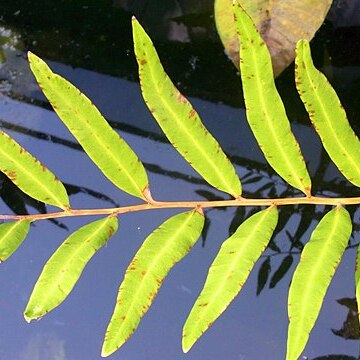Plants 1-1.5 m tall. Rhizome scales dark brown to black, broadly lanceolate, ca. 1 × 0.2-0.3 cm. Stipe straw-colored, 30-40 cm, 0.3-0.5 cm in diam., glabrous; lamina 35-50 × 20-30 cm; lateral pinnae to 5-8 pairs; sterile pinnae lanceolate, (8-) 15-20 × 2-2.5 cm, with stalk 0.5-1 cm, thickly leathery, both surfaces glabrous, base narrowly cuneate, margin entire and cartilaginous, apex narrowly acuminate; costae strongly raised abaxially, flat or slightly grooved adaxially; veins raised abaxially, hardly visible adaxially, closely spaced, anastomosing. Fertile pinnae distal on frond, like sterile pinnae but somewhat abruptly attenuate and shortly caudate.
Rhizome scales to c. 8 mm long. Fronds 1–1.5 (–3) m tall. Lamina dull green. Sterile pinnae usually to c. 10 (–15) cm long, 2.5–3.5 cm wide, sometimes larger; apex narrowly acuminate. Fertile pinnae smaller; apex narrowed, sometimes with a short abrupt point to c. 5 mm long.


